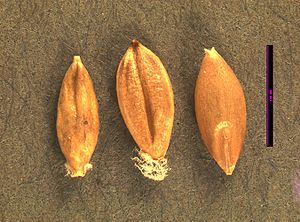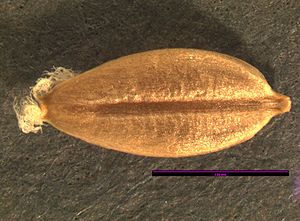Danthonia californica
Contents
Danthonia Californica
Family: Poaceae, Synonyms: Danthonia Americana, California Oatgrass, four botanical varieties of Danthonia californica: var. americana, var. californica, var. palousensis, and var. piperi.
Taxonomy
Description
California wild oat grass is a low, perennial bunchgrass, to 1 1/2 ft. tall, with dense tufts of fuzzy, dull-green leaves and half-decumbent flowering culms with nodding spikelets. This grass is not particularly conspicuous even in flower.
Perennial, tufted grass from fibrous roots; stems disarticulating at the nodes (ten) 30-130 cm tall. Leaves: Sheaths smooth or soft hairy, the upper ones usually smooth or unevenly soft hairy, the hairs 1-2 mm; blades (one) 2-5 (6) mm wide, flat to in-rolled, smooth to soft hairy; ligules less than 1 mm long, fringed with fine hairs. Flowers: Inflorescence a raceme of (two) three to six (ten) slightly to broadly spreading spikelets, the branches longer than the spikelets; spikelets (ten) 14-26 (30) mm long; lemmas 5-10 mm long, hairy along the margins, rarely smooth, sometimes sparsely hairy over the back, the apical teeth stiff-awned, (2) 4-6 (7) mm long, also awned from the back, these awns abruptly bent, (7) 8-12 mm long, the calluses usually longer than wide, with stiff hairs laterally; anthers to 4 mm long (Douglas et al., 2001). Source: The Illustrated Flora of British Columbia
California oatgrass (family: Poaceae) is a slow establishing yet long lived, cool season (C3) perennial bunchgrass of intermediate texture. Its stems (culms) grow 30-100 (10-130) cm tall and disarticulate (separate) at the lower nodes (joints). The leaf sheaths are smooth to densely hairy. Leaves are both basal and attached to the stem with the upper blades being 8-25 (10-30) cm long, flat to in-rolled, and spreading to abruptly bent. The ligule (at the throat of the leaf blade) is less than 1 mm and fringed with small straight hairs. Additionally, 1-3 mm long, soft spreading hairs appear at the leaf collar and throat (photo). Flowering occurs in May or June depending on location. The panicle (inflorescence) is 2-6 cm long, loose, and open with 1-5 (3-6) broadly spreading spikelets. Glumes are 14-18 mm long. There are 3-8 (5-10) florets (flowers) per spikelet (see photo). Lemmas are 5-10 (8-15) mm long, hairy along the margins with stiff awned teeth and an abruptly bent awn that is (4) 8-12 mm long (Darbyshire 2003, Hickman 1993, Hitchcock et al. 1969, Klinkenberg 2007).
Bloom Period
Distribution
Habitat
Uses
Propagation
Photo Gallery
Seed
Abbreviation: DACA
Seed sample from: 2011
Average Measurement with husk/awn: 13.75 x 1.5 x 0.8
Measurement Range with husk/awn: L: 12 - 16, W: 1.2 - 1.9, D: 0.75 - 1
Average Measurement without husk/awn: 3.5 x 1.5 x 0.9
Measurement Range without husk/awn: L: 3.25 - 3.75, W: 1.3 - 1.75, D: 0.75 - 1.1
Features
Shape: Seed tapered at ends, hilum flared into two points.
Color: Seed light brown, husk cream colored.
Additional Features: Lemma sharply pointed and has several nerves. Palea rounded at top. Lemma fringed at inner edge with, white bristles and bearded at hilum. Awn cork screws once or twice and then straightens.
Surface: One seed face has a groove that runs longitudinally almost entire length of seed. The opposite seed face has a depression that forms an elliptical ridge. Seed is very finely textured with longitudinal lines and is slightly shiny.
Latitudinal Cross Section: elliptical ![]()
Longitudinal Cross Section: elliptical ![]()
Basic Explanations and Assumptions:
The dimensions for the seeds are length x width x depth. The location of the hilum is used as the base of the seed, and the length is measured from hilum to the opposite apex. Where a style is present, the length is measured from the hilum to the bottom of the style. Width is measured at a right angle to the length at the widest part. Depth is measured at a right angle to the intersection of height and width lines.
Measurements included are the mean average for each measurement of ten separate seeds.
All measurements in millimeters unless otherwise noted.


